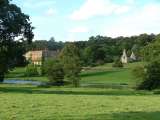
Bale Bayfield Field Dalling Glandford Holt Saxlingham
home I index I introductions I e-mail I about this site
St Margaret, Bayfield
Read
the captions by hovering over the images, and click on them to
see them enlarged.



| St
Margaret, Bayfield I had been hopeful of seeing the ruins of St Margaret, even though they are marooned in the grounds of Bayfield Hall away from any public footpaths. My optimism arose from the fact that even the rich need to earn a living these days, and Bayfield Hall is home to a garden centre. However, by the time we got there it had already closed for the day. Giving up, we drove on down the road to Holt, when all at once through a gap in the hedgerow there was a panoramic view over the Glaven valley, the great house nestling on the far side of the river below the field, the ruins of St Margaret beside it. In the 19th century, Bayfield Hall was the home of Sir Alfred Jodrell, who paid for the comprehensive restoration of Glandford (which had been a ruin) and Saxlingham, as well as contributing largely to the restoration of Salle. I found it interesting that he had his own ruin here in his back garden. We climbed the gate and walked out into the field. It swept away to north and south, following the line of the river. It appeared to be empty, and although I was careful and anxious enough to check for bulls (I know there is one somewhere with my name on it) the liberal quantities of sheep shit scattered about suggested that I would not be meeting my nemesis today. We wandered down to the river. I have to say that the view was stunning; what a wonderful place to live. I was torn between a fit of envy and reapplying myself to the purchase of lottery tickets. Pevsner describes it kindly as the ruined church of a lost village, but in reality the village was probably 'lost' on purpose by the owners of the hall and park. The bellcote looks Victorian to my eyes, but apparently it was a ruin by the end of the 18th century, so unless the bells were added as a neat folly touch after ruination (which isn't impossible) they are old. Intriguingly, the chancel arch is filled in, as so many must have been once before the 19th century revival returned chancels to their original use. From the distance I was standing, it looked as if the chancel might have been ruined before the rest. Pevsner detected the remains of a transept on the north side, a common feature round here, and possibly the remains of an apse to the east of the chancel. But I was too far away to see. However, friend of the site Chris Harrison, a braver man than me, fought his way to the far side of the river and obtained the photographs below. The most intriguing feature is the filled-in chancel arch. It has been filled in twice; firstly the hole arch except for a doorway, presumably to create a separate space as something like a schoolroom, presumably in the late 16th century. This must have happened with so many medieval churches, but virtually all evidence is lost to us. The survival here is vitally significant. And then the doorway was filled in. In the 18th century, when Bayfield had grown so small that the now-ruined chancel was no longer required? Who can say. Fascinating stuff. Simon Knott, November 2004 You can also read: Our Daily Bread: some ordinary Norfolk churches |
Bale Bayfield Field Dalling Glandford Holt Saxlingham
home I index I latest I introductions I e-mail I about
this site I glossary
Norwich I ruined churches I desktop backgrounds I round tower churches
links I small
print I www.simonknott.co.uk I www.suffolkchurches.co.uk